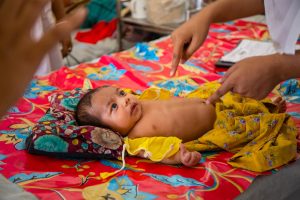
One-month-old Saiful is treated for pneumonia in a hospital in Barisal district, Bangladesh. September 2018. Save the Children is helping to train healthcare providers to diagnose and treat pneumonia at the community level.
Background
Globally in 2017 neonatal death accounted for 46% of under-five deaths. Nepal is among the developing countries which has a high number of neonatal deaths. The rates are high among poor socio-economic groups, marginalized, as well as people living in remote areas of Nepal. This paper, thus tries to examine the utilization pattern and maternal, household, and health service factors affecting underprivileged ethnic groups in Midwest Nepal.
Methods
A cross-sectional mixed method study was conducted from September 2017 to April 2018 in Bardiya district. Quantitative data were collected from a household survey of women who gave live births within the last 12 months prior to data collection (n = 362). Interviews were also undertaken with 10 purposively selected key informants. Logistic regression model was used to determine the factors associated with essential neonatal care utilization. Thematic analysis was undertaken on the qualitative data.
Results
Overall, neonatal care utilization was 58.6% (53.3–63.7%), with big variations seen in the coverage of selected neonatal care components. Factors such as birth order (2.059, 1.13–3.75), ethnicity (2.28, 1.33–3.91), religion (2.37, 1.03–5.46), perceived quality of maternal and neonatal services (2.66, 1.61–4.39) and awareness on immediate essential newborn cares (2.22, 1.28–3.87) were identified as the determining factors of neonatal care utilization.
Conclusions
The coverage of birth preparedness and complication readiness, adequate breastfeeding, and postnatal care attendance were very low as compared to the national target for each component. The determinants of essential neonatal care existed at maternal, household as well as health facility level and included ethnicity, religion, perceived quality of maternal and neonatal services, birth order and awareness on immediate essential newborn care. Appropriate birth spacing, improving the quality of maternal and neonatal services at health facilities and raising mother’s level of awareness about neonatal care practices are recommended.